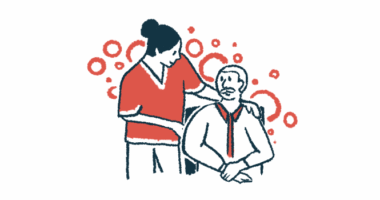Listen! Can You Hear Me Now?

Living with ALS has taught me to adapt, adapt, and adapt. Because ALS symptoms tend to change, change, and change. And one of the symptoms I’ve been learning to adapt to is dysarthria, or losing the ability to speak.
Dysarthria feels like having a bad case of laryngitis and a lazy tongue that is two steps behind what my mind wants to say.
Exploring my options
In the beginning, I poked fun at my “angry pirate” voice. Having spam callers hear my gruff “Har-row?” and hang up on me felt like a victory of sorts.
But long, in-person conversations with friends became tiring. And I knew that even though they nodded politely, they weren’t always understanding me. Like every other ALS patient with dysarthria, I was told by my medical team that eventually I would lose the ability to speak and that assistive technology would speak for me.
Out-of-the-box thinking
I didn’t want to give up so easily. Two years ago, I wrote about how I was using Andrea Caban’s innovative techniques to help save what little voice I had.
The techniques included sitting up tall, speaking with a higher or lower pitch, moving consonants to the front of the mouth, and using the diaphragm like an opera singer while speaking. I was happy with the results and could produce longer sentences with each breath.
Being on a roll, I explored YouTube videos for beginning singers. Turns out there are lots of helpful lessons for “fragile voices.”
I learned the value of humming, memorized several easy vocal warmups, and improved my diaphragmatic exhalation so that I could recite 30 words in one breath!
A clinic discussion
During a recent visit to my ALS clinic, I proudly shared everything with my speech-language pathologist. She happily acknowledged my improvement and said she was satisfied with my vocal status.
“But,” she added, holding a finger in the air, “what you need is a personal amplification device. You know, a portable microphone!”
Hmmm. Why didn’t I think of that?
She turned to the computer in the room, called up a website, and showed my husband and me the screen.
My mind flashed to the possibilities. No more straining to be heard in noisy restaurants. No more frustration in crowded social gatherings. No more hollering across the house when my husband forgets how to copy and paste on his computer. (I’m sure we’re the only couple that sits in two different rooms while on our computers and hollers our conversations!)
I could immediately visualize the advantages.
Next steps?
My personal microphone is on order and it should arrive soon. I’m looking forward to testing it out in all kinds of situations and sharing my experiences in a future column.
Remember: Always be open to new ideas, be willing to adapt, and live well while living with ALS.
***
Note: ALS News Today is strictly a news and information website about the disease. It does not provide medical advice, diagnosis, or treatment. This content is not intended to be a substitute for professional medical advice, diagnosis, or treatment. Always seek the advice of your physician or other qualified health provider with any questions you may have regarding a medical condition. Never disregard professional medical advice or delay in seeking it because of something you have read on this website. The opinions expressed in this column are not those of ALS News Today or its parent company, Bionews Services, and are intended to spark discussion about issues pertaining to ALS.







John Russell
Love your attitude Dagmar. To me gadgets and shopping for them are one of the rare things that make ALS fun. Can't wait to hear how you do with your microphone. I appreciate your tips & links on maintaining speech. I began to notice problems just starting last March.
Dagmar Munn
Thank you John - - I'll be reporting (and writing about) my progress in the next few weeks. Right now, it's a learning curve with the volume control - - I sometimes find myself addressing the whole neighborhood! ;-)
Diana Belland
As always, another great column, Dagmar! Your sense of humor always makes me smile, and your concluding sentence, "Always be open to new ideas, be willing to adapt, and live well while living with ALS" is such good advice. I need to remind myself of that daily!
I'm looking forward to hearing about your first experience with the personal microphone.
Dagmar Munn
Yes, Diana.... we must always "think like a chameleon" :-) ....as in, "what do I need to do in order to fit in here?" :-)
Elizabeth Rothgeb
Dagmar,
You have given me great ideas! As a retired educator, struggling to get my "rapid fire" thoughts out in less than 45 minutes is certainly a tripping point. ;-)
Adapt, adapt, adapt, but changing pitch and breathing exercises is brilliant!
Can't wait to hear how the personal microphone works!
Betty
fbe
Hi from Spain, thanks Dagmar for your positive columns. You are an inspiration for my wife. She was diagnosed 1 year ago, and it's increasingly difficult to live with that. Reading you often makes her feel better.
Dagmar Munn
I you haven't already found it... here is my personal blog: https://alsandwellness.blogspot.com/2017/09/als-and-wellness-blog-archives.html
Lots of motivation & tips for your wife to explore :-)
fbe
We will take a look! thank you
Bill Meacham
I am curious, what device did you get? They gave me one at my local clinic but I haven’t used it. This one came with one mic that looks kind of like the ones sportscasters use and another that fits on the throat.
I’ll be watching to see how yours works.
Dagmar Munn
This is the model: https://zoweetek.cn/product-item/zoweetek-10w-portable-mini-voice-amplifier-with-wired-microphone/
I ordered it through Amazon.
So far, so good. Helps my husband hear me when we're in our van and, definitely carries my voice to the other room (or over the noise of football on TV!). More thoughts coming soon!
Darchelle
What microphone did you go with?
Thanks!
Richard Schmidt
Dagmar, God Bless you and your approach to living with ALS and sharing with us. I will be praying you. I have Isolated Bulbar ALS so any topics on speaking or speech are particularly key to me right now as my symptoms which started about 10 years ago seem to be speeding up. Take care and keeop us posted on the results with the portable amplifier system.
Darchelle
I just realized you included it in the column. Thanks :)
Gail
I have a voice amplifier and it really has been helpful. I use in restaurants, in a vehicle or in meetings so I can speak and be heard!
I always enjoy your column.
Dagmar Munn
That is certainly good to hear Gail. I hope mine will be as useful :-)
Rod Dalglish
I lost the ability to speak 18 months ago, I have found that a "boogie board" is my preferred communication tool. I have a text to speech app on my iPad, but as I can write faster than I can type I rarely use it. In Australia the MND association provides these FOC, but they can be bought online for as little as $28.00. Light, compact, cheap and virtually indestructible, I find these electronic note pads a must have?
Dagmar Munn
Yes Rod, Boogie Boards are also great! It's also easier for others to read as well.
For those who don't yet know about Boogie Boards, here's a past column I wrote about them: http://alsnewstoday.com/2017/12/05/als-dysarthria-led-me-to-join-boogie-board-club/
Susan Gray
Yes! I look forward to your columns every week. Thank you for more good advice once again! You are indeed such an inspiration to so many of us. I often find myself thinking WWDD (What Would Dagmar Do?), and then I go to your blog. ♥️
Julie Vander Meulen
Dagmar, your light shines bright, and your experiences are enlightening for all.
Glad you can still TYPE!
Kerry Winkler
Dagmar - yet another great article with very helpful information. I’ve just started to experience the “thick tongue” sensation, so now strategizing for what’s ahead. A question for you - what is the loss of voice volume control related to, i.e. loss of breathing capacity, weakened vocal cords or something else?
Dagmar Munn
For me, the loss of volume was due to breathing capacity - - speaking; pushing words out via my upper rib cage area just wasn't enough. When at the ALS Clinic and asked to yell "Hey," I was able to do that by using my diaphragm and abdominal muscles. So, learning to switch from upper ribs to belly when speaking helped tremendously. However, with my new lower pitch and monotone, my voice gets lost in noisy environments - - that's where having a personal microphone helps!
Andrea Chapman Day
Dear Friend... You never fail to amaze me! When I think of all the support, understanding, humor & knowledge you are sharing with others-‘not just those living with ALS, but their families & others, I so realize you are actually the very same as you were when helping others live their best lives decades ago in your TV program on fitness & wellness! WE are blessed to be part of your life!
Dagmar Munn
Thank you Andi :-) Hugs to you across the miles!
Cath Muir
I was just the same, not being heard in noisy environments.
I mentioned the idea of an amplifier to the speech therapist who said she would look into it for me. Anyway I recieved one from Parkinsons UK. It's great, it came last week and make a huge difference. I can also plug it into my phone so when making calls it amplifies my voice. You will find yours really useful.
Bill Hayden
Dagmar, I was just officially diagnosed last month. I have heard of a device that will record your voice so you can use it in the future after losing ones voice. Can you suggest where I might start to research and acquire that?
Dagmar Munn
Bill, there are quite a few sites and apps that do this - - just Google "voice banking" and you'll find them.
I have my own opinion regarding voice banking (you don't "get your voice back," rather, a computerized version comes out of a nearby device) and wrote about it here: http://alsnewstoday.com/2019/08/20/voice-banking-dysarthria/
But, we all have differing reasons for considering voice banking. The best outcome of course, is never losing your voice at all!